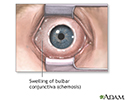Chemosis
Fluid-filled conjunctiva; Swollen eye or conjunctivaChemosis is swelling of conjunctiva the tissue that lines the eyelids and surface of the eye.
Conjunctiva
The conjunctiva is a thin, clear membrane that covers the inner surface of the eyelid and the white part of the eyeball (the sclera). It contains ma...

Considerations
Chemosis is a sign of eye irritation. The outer surface of the eye (conjunctiva) may look like a big blister. It can also look like it has fluid in it. When severe, the tissue swells so much that you can't close your eyes completely.
Chemosis is often related to allergies or an eye infection. Chemosis can also be a complication of eye surgery, or it may occur from rubbing the eye too much.
Causes
Causes may include:
-
Angioedema
Angioedema
Angioedema is swelling that is similar to hives, but the swelling is under the skin instead of on the surface. Hives are often called welts. They a...
 ImageRead Article Now Book Mark Article
ImageRead Article Now Book Mark Article -
Allergic reaction
Allergic reaction
The conjunctiva is a clear layer of tissue lining the eyelids and covering the white of the eye. Allergic conjunctivitis occurs when the conjunctiva...
 ImageRead Article Now Book Mark Article
ImageRead Article Now Book Mark Article - Bacterial infection (conjunctivitis)
Conjunctivitis
The conjunctiva is a clear layer of tissue lining the eyelids and covering the white of the eye. Conjunctivitis occurs when the conjunctiva becomes ...
 ImageRead Article Now Book Mark Article
ImageRead Article Now Book Mark Article - Viral infection (conjunctivitis)
Home Care
Over-the-counter antihistamines and cool compresses placed on the closed eyes may help with symptoms due to allergies.
When to Contact a Medical Professional
Contact your health care provider if:
- Your symptoms do not go away.
- You can't close your eye all the way.
-
You have other symptoms, such as eye pain, change in vision, difficulty breathing, or fainting.
Eye pain
Pain in the eye may be described as a burning, throbbing, aching, or stabbing sensation in or around the eye. It may also feel like you have a forei...
 ImageRead Article Now Book Mark Article
ImageRead Article Now Book Mark ArticleDifficulty breathing
Breathing difficulty may involve:Difficult breathing Uncomfortable breathingFeeling like you are not getting enough air
 ImageRead Article Now Book Mark Article
ImageRead Article Now Book Mark Article
What to Expect at Your Office Visit
The provider will perform a physical exam and ask questions about your symptoms, which may include:
- When did it start?
- How long does the swelling last?
- How bad is the swelling?
- How much is the eye swollen?
- What, if anything, makes it better or worse?
- What other symptoms do you have? (For example, breathing problems)
Your provider may prescribe eye medicine to reduce swelling and treat any conditions that may be causing the chemosis.
References
Fernandez A, Asbell P, Roy N. Emerging therapies targeting eosinophil-mediated inflammation in chronic allergic conjunctivitis. Ocul Surf. 2022;26:191-196. PMID: 35970432 pubmed.ncbi.nlm.nih.gov/35970432/.
Kumar NM, Barnes SD, Pavan-Langston D, Azar DT. Microbial conjunctivitis. In: Bennett JE, Dolin R, Blaser MJ, eds. Mandell, Douglas, and Bennett's Principles and Practice of Infectious Diseases. 9th ed. Philadelphia, PA: Elsevier; 2020:chap 112.
McNab AA. Orbital infection and inflammation. In: Yanoff M, Duker JS, eds. Ophthalmology. 6th ed. Philadelphia, PA: Elsevier; 2023:chap 12.14.
Rubenstein JB, Kelly E. Infectious conjunctivitis. In: Yanoff M, Duker JS, eds. Ophthalmology. 6th ed. Philadelphia, PA: Elsevier; 2023:chap 4.6.
-
Chemosis - illustration
Chemosis is swelling of the eye surface membranes because of accumulation of fluid. This symptom is often related to an allergic response. Over-the-counter antihistamines, and a cool cloth placed over the eyes, are usually used to try to alleviate the symptoms.
Chemosis
illustration
-
Chemosis - illustration
Chemosis is swelling of the eye surface membranes because of accumulation of fluid. This symptom is often related to an allergic response. Over-the-counter antihistamines, and a cool cloth placed over the eyes, are usually used to try to alleviate the symptoms.
Chemosis
illustration
Review Date: 4/29/2025
Reviewed By: Franklin W. Lusby, MD, Ophthalmologist, Lusby Vision Institute, La Jolla, CA. Also reviewed by David C. Dugdale, MD, Medical Director, Brenda Conaway, Editorial Director, and the A.D.A.M. Editorial team.


